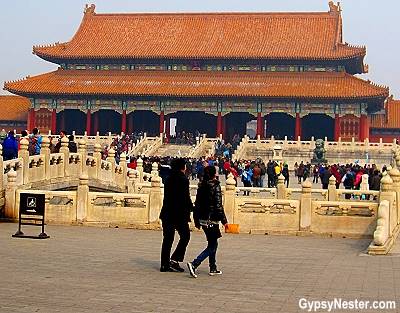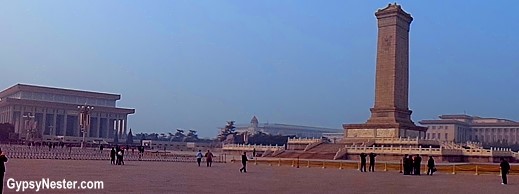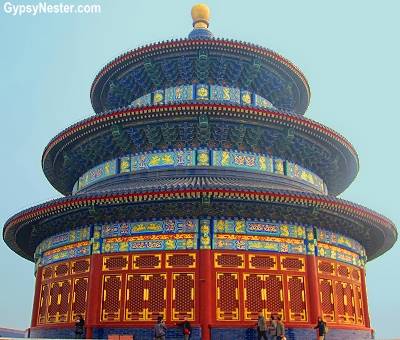
To those of us who grew up in the “eat your vegetables, there are starving kids in China” era, visiting Beijing really seemed like a trip into a forbidden city.
Back then the city was known to us a Peking, and pretty much all we knew about it involved ducks.
We never thought of it as a place we might someday see, but after seeing The Great Wall we were willing to believe almost anything was possible.
Forbidden, No More
Beijing is huge, and incredibly crowded, so we opted to join one of the tour groups from our ship, The Volendam. This saved us from wasting any time getting lost, and allowed us to skip the long lines waiting to enter the real Forbidden City.

Walls over twenty-five-feet high surround the so-called city, which was actually an imperial palace from the Ming Dynasty to the end of the Qing Dynasty, up until the last emperor abdicated in 1912.
Through twenty-four emperors over five hundred years, this served as the center of power for the vast empire.

We passed through the wall at the Meridian Gate and entered the The Outer Court.
This was the area used for ceremonial purposes, such as weddings and coronations.
Across a large courtyard, and the small stream of the Golden Water River, another gate awaited us.
The Gate of Supreme Harmony…


…opened into another large open area dominated by The Hall of Supreme Harmony the largest wooden structure still standing in China.
We weren’t allowed inside the hall, things like the imperial throne must be protected from people like us sitting on them, but we did get a good look inside. Looks like it was good to be king.


Moving on, we passed through another gate and entered The Inner Court.
This was the most protected area, home to the emperor and his family.
The Emperor, representing Yang and the Heavens, occupied the Palace of Heavenly Purity.

Meanwhile The Empress, being the Yin and the Earth, would stay in the Palace of Earthly Tranquility.
Between the two, the Hall of Union stands where the Yin and Yang meet and produce harmony.
One way we could tell that we were entering increasingly important parts of The Forbidden City was by counting the small statues along the corners of the building roofs.
The more figures, the higher the status of the building. In the Outer Court they had only three, with more added as we passed through each gate.
Finally, The Hall of Supreme Harmony has ten, the most allowed on any building during the imperial rule.

We left the walls through the Gate of Divine Might and then made our way around to Tiananmen Square.
The square takes its name from no longer existent gate, Tiananmen gate (Gate of Heavenly Peace), but is much better known for playing a big part in more modern Chinese history.
Checking out the Chairman

Built in 1651, but it wasn’t until three hundred years later that Mao Zedong’s vision of the world’s largest square began to take shape. He oversaw expansions that made room for half a million people.
After his death a mausoleum was placed near the center and the size expanded yet again so that now 600,000 people can gather.

From all we could see Chairman Mao is still celebrated and revered here, but when us clean plate kids became adults a very different picture of the square was burned into our memories.

The images from June 1989 of protesters in the square, especially one young man standing down a tank, are the first thing to come to mind when we hear Tiananmen Square.
Those events are not officially recognized, but our guide was completely open about them and pointed out the spot where they happened, so they do not seem to have been covered up.
A Heavenly Temple

Not far from the square, we stepped back into more ancient history at The Temple of Heaven.
Beginning six hundred years ago, at the same time that The Forbidden City was built, Emperors of the Ming and Qing dynasties used this site for annual ceremonies to pray for a good harvest.

We walked through a large park to reach the sacred site, where we were offered any manner of trinkets, souvenirs, and knock off watches by enterprising entrepreneurs.
This was not unique to this spot though, it happened every time we got off the bus. Certainly seems as if capitalism is catching on.

But we found the groups along the walkway playing games much more interesting than a fake Rolex.
Spirited bouts involving grand, energetic placement of cards or pips had drawn large crowds of both players and spectators, and made for an entertaining stroll to the temple.


Perhaps the word temple is misleading, there are actually several buildings making up the complex. The Hall of Prayer for Good Harvests stands out, and above, the rest as the focal point.
Every bit of the impressive circular building is wood, and it was made without any nails. Unfortunately what we see now is a reconstruction, since the original was struck by lightning and burned in 1889.
See more details photos of the Temple of Heaven
It’s Always Nice to Have a Summer Home!

Our final stop, The Summer Palace, lies on the northwest edge of Beijing by Kunming Lake, in what used to be countryside.
As the name implies, this was the imperial getaway from summer in the city. As with the previous temple, palace only describes a part of this place.

What we found was hardly a summer cottage for the emperor, there are nearly three square miles of gardens, statues, and temples surrounding the lake.
All the culmination of centuries of emperors adding to the splendor since the Jin Dynasty, when emperor Wányán Liàng chose the site back in the middle of the twelfth century.
See more photos and info about The Summer Palace

Perhaps the best known of these leaders was one of the last, the controversial Empress Dowager Cixi.
In 1862 she declared herself empress by command of her six year-old son, the Emperor Tongzhi.
When her son died at only eighteen years-old, she appointed her nephew emperor and “retired” to The Summer Palace.
But she was hardly out of the picture, continuing to rule from behind the scenes. During this “retirement” she spent what would now be hundreds of millions of dollars on refurbishing the palace and grounds, nearly bankrupting the Chinese military.

There is little doubt that this led to defeat in the Sino – Japanese war in 1895. The fall of China‘s dynasty system, along with drastic changes, soon followed. When our guide was telling us this story it was hard to determine whether he felt this was a good thing or a bad thing.
See more photos and info about The Summer Palace
One thing we could say for sure though, today’s China is a very different place than we ever dreamed of back when we were sitting at the table trying to hide some broccoli in our napkins.
David & Veronica, GypsyNester.com
See more of our adventures in China!
Click here for our full live-blog as we traveled with Holland America aboard the ms Volendam – through Hong Kong, China, South Korea and Japan




Your photos are wonderful. What a splendid trip. I especially enjoy the history you’ve included about Beijing. Had to laugh about the “starving children in China” – how well I remember that phrase. And I still clean my plate. Yikes!
We do too. Old habits die hard.
Haha – I agree with you about the housework. It’s a wonder she had time for anything else.
I really want to hike the Great Wall and visit a panda sanctuary, but I’m not sure I could handle the crowded cities.
The crowds weren’t as much of an issue as the smog. It was supposedly not bad while we were there, but it definitely was noticeable.
I love the summer palace and can’t wait to visit the Forbidden City at the end of the year. Thanks for sharing!
Have a great trip Taylor!
It’s a very beautiful city!! I love the photos. Thanks for sharing.
Thanks Mary!
Did you guys get to check out the pavilion on top of the hill in Jingshan Park, just across from the Forbidden City? Really cool views from up there.
We saw it but didn’t get up there. Wish we had.
Loved your photos and the great reminder about how much I enjoyed the Temple of Heaven. I think I liked it even better than The Forbidden City.
Thanks Donna, good to hear from you!
Ha, my mum always said that there were starving children in Africa 😉 Great post though, thanks for sharing your insights into travelling to this fascinating part of the planet. The kids were learning Chinese at school, so I think as long we don’t need to count higher than 10, or travel further than the toilet we should be fine 🙂
Good one, but don’t worry, we didn’t have a clue what anyone was saying and we got by fine. 😉
Wow, I’ve never felt the desire to visit China, but I might need to reconsider that. Great inspiration, this post! Love it 🙂
Thanks Bram, it was very interesting.